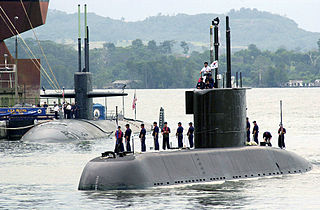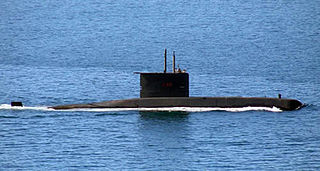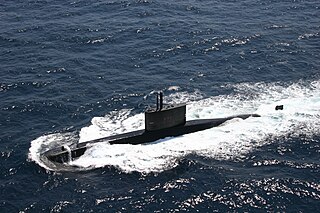
An attack submarine or hunter-killer submarine is a submarine specifically designed for the purpose of attacking and sinking other submarines, surface combatants and merchant vessels. In the Soviet and Russian navies they were and are called "multi-purpose submarines". They are also used to protect friendly surface combatants and missile submarines. Some attack subs are also armed with cruise missiles, increasing the scope of their potential missions to include land targets.

The Scorpène-class submarines are a class of diesel-electric attack submarines jointly developed by the French Naval Group and the Spanish company Navantia. It features diesel propulsion and an additional air-independent propulsion (AIP). It is now marketed as the Scorpène 2000.

The Type 209 is a range of diesel-electric attack submarines developed exclusively for export by Howaldtswerke-Deutsche Werft of Germany. Five class variants, including modifications thereof, have been successfully exported to 15 countries, with 68 submarines being built and commissioned to five different variants between 1971 and 2021. More boats have been built to modified designs.

The TR-1700 is a class of diesel-electric patrol submarines built by Thyssen Nordseewerke for the Argentine Navy in the 1980s, with two submarines completed. These ships are amongst the largest submarines built in Germany since World War II and are among the fastest diesel-electric submarines in the world. ARA San Juan was lost on 17 November 2017, leaving ARA Santa Cruz as the only remaining submarine of this class. As of 2020, the refit of Santa Cruz has been reported cancelled leaving the entire class inactive.

ROKS Jang Bogo (SS-061) is the lead ship of the Jang Bogo-class submarine of the Republic of Korea Navy, and was the first submarine to serve with the navy. It is one of the Type 209 submarines built for export by Germany.

Gölcük Naval Shipyard is a naval shipyard of the Turkish Navy within the Gölcük Naval Base on the east coast of the Sea of Marmara in Gölcük, Kocaeli. Established in 1926, the shipyard serves for the building and the maintenance of military vessels. A total of 3,221 personnel are employed at the shipyard stretching over an area of 255,526 m2 (2,750,460 sq ft) with covered structures of 121,466 m2 (1,307,450 sq ft).

S Tikuna (S-34) is a Type 209 submarine of the Brazilian Navy. Built in the Brazilian Navy Yard in Rio de Janeiro (AMRJ), it was launched in March 2005 and incorporated into the Brazilian Navy on July 21, 2006, and then transferred to the Naval Operations Command. It is the fourth Brazilian Navy submarine made in Brazil and the largest ever built in the country. The name of this submarine is a tribute to South American indigenous tribe Tikuna inhabiting the region of the Upper Solimões, in the western part of the State of Amazonas.

The Jang Bogo-class submarine or KSS-I is a variant of the Type 209 diesel-electric attack submarine initially developed by Howaldtswerke-Deutsche Werft (HDW) of Germany, intended for service with the South Korean Navy and Indonesian Navy. A Daewoo (DSME)-upgraded model of the Jang Bogo class Type 209 was exported by Korea to Indonesia in 2012, amid heavy competition from Russian, French, and German-Turkish consortiums including from Germany's original Type 209. The variant was considered for possible purchase by Thailand as well, as both newly built and second-hand options. The class is named for ancient Korean maritime figure Jang Bogo.

ROKS Yi Cheon (SS-062) is the second ship of the Jang Bogo-class submarine of the Republic of Korea Navy, and was the second submarine to serve with the navy. She is one of Jang Bogo-class submarines to be built in South Korea.

ROKS Choe Museon (SS-063) is the third ship of the Jang Bogo-class submarine of the Republic of Korea Navy, and was the second submarine to serve with the navy. She is one of Jang Bogo-class submarines to be built in South Korea.

ROKS Park Wi (SS-065) is the fourth ship of the Jang Bogo-class submarine of the Republic of Korea Navy, and was the third submarine to serve with the navy. She is one of Jang Bogo-class submarines to be built in South Korea.

ROKS Lee Jongmoo (SS-066) is the fifth ship of the Jang Bogo-class submarine of the Republic of Korea Navy, and was the fourth submarine to serve with the navy. She is one of Jang Bogo-class submarines to be built in South Korea.

ROKS Yi Sun-sin (SS-068) is the seventh boat of the Jang Bogo-class submarine of the Republic of Korea Navy. She is one of Jang Bogo-class submarines to be built in South Korea.

ROKS Na Dae-yong (SS-069) is the eighth boat of the Jang Bogo-class submarine of the Republic of Korea Navy. She is one of Jang Bogo-class submarines to be built in South Korea.

S Tamoio(S-31) was the second Tupi-class submarine of the Brazilian Navy.

S Timbira(S-32) was the third Tupi-class submarine of the Brazilian Navy.

S Tapajó(S-33) was the fourth boat of the Tupi-class submarine of the Brazilian Navy.



















